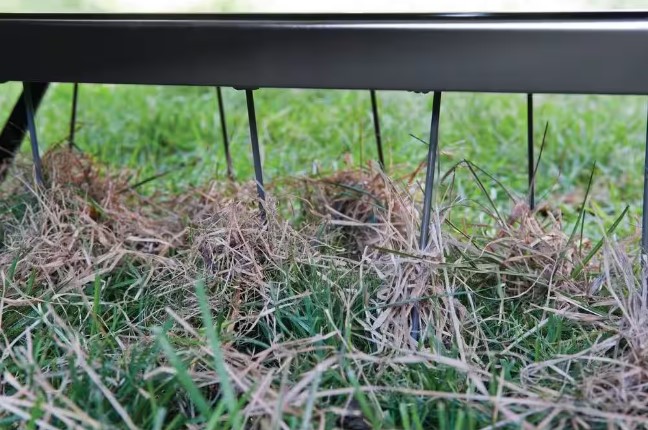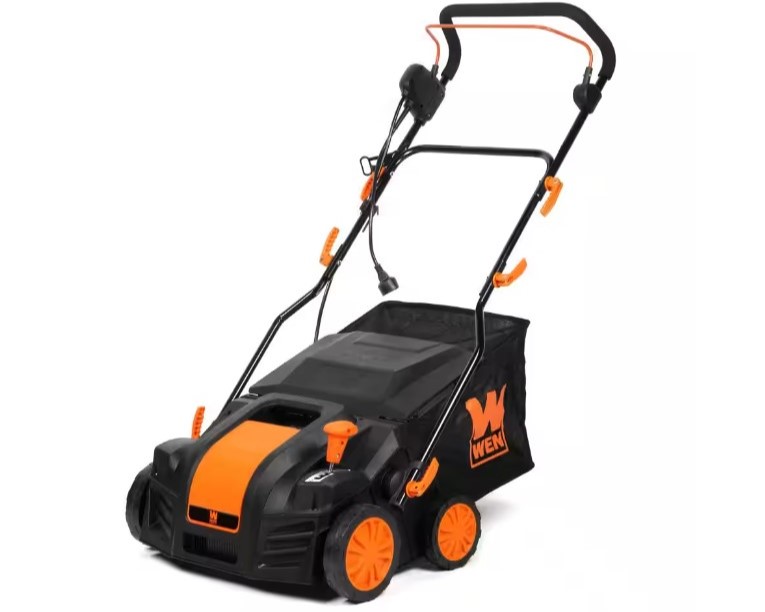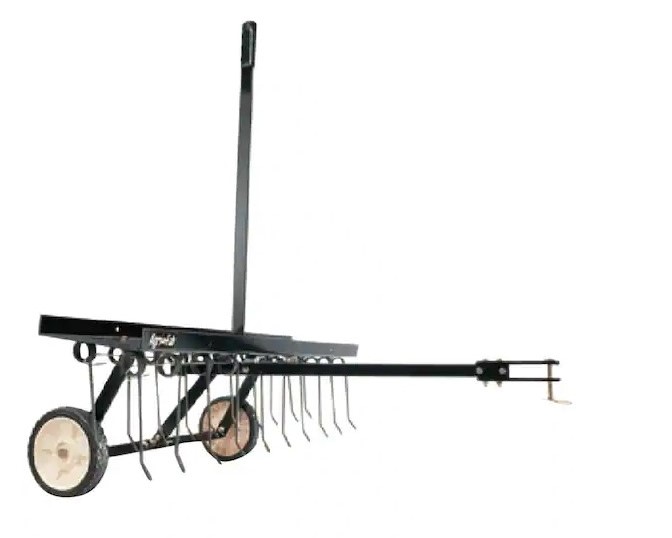What is a dethatcher?
An easier-going tool to remove moss and thatch for a healthy lawn

Between the roots and the foliage of your lawn grass, there’s a layer of dead grass and other natural debris, known as thatch.
Some thatch is a good thing. It acts as mulch, fertilizing the lawn while providing insulation and moisture retention. However, when the thatch accumulates to a thickness of over half an inch, it may block nutrients and water from reaching the roots, leaving the grass potentially undernourished and dehydrated.
This is where a dethatcher comes into play so you can dethatch your lawn. Whether they’re powered by gas, electricity or the strength of your arm, these tools can be pulled across the surface of the lawn to remove thatch while leaving most of the healthy grass intact. As the tool's name suggests, this process is called dethatching.
In this guide, we’ll take you through how dethatchers work, and how to use these tools correctly. We’ll also introduce you to some popular, highly-rated models of dethatcher that you can use to dethatch your lawn.
3 of the best dethatchers you can buy in 2023

This outstanding foot-wide dethatching rake head is part of Wolf-Garten’s multi-change system, which also includes attachments for hoeing, weeding and various other types of yard work. It should be used with a compatible Wolf-Garten handle (sold separately – here in the US, and here in the UK). While using a manual dethatcher like this one is more strenuous than using a powered option, it provides the highest degree of control over the intensity of dethatching.

This low-effort, high-impact, corded electric dethatcher from WEN is great for dethatching a wide variety of lawns – just as long as there’s a power outlet within reach. The tool also has a scarification attachment, so you can use it for the more intensive process of scarifying your lawn.

Got a big lawn to dethatch? If so, consider getting a towed tine dethatcher to attach to the rear of your ride-on lawnmower. These tools take the effort out of dethatching, by doing the job for you while you mow. One great example of this dethatcher type is the Agri-Fab 40-in Dethatcher, which features 20 durable spring tines and a universal hitch that fits pretty much any tractor.
What is a dethatcher?
A dethatcher is a tool used to pull up some of the thatch from your lawn – without aggressively digging the grass or soil.
Dethatchers perform this action using an array of tines. When pulled over the lawn surface, these long, slender prongs pull up some of the thatch, which increases the amount of space among the living grasses.
Dethatching is a simple process. You pass your chosen dethatching tool over the surface of the lawn, until you’ve pulled up a layer of brown thatch. You can then collect the thatch, water the lawn and seed any bare areas to encourage regrowth.
Sign up to receive the latest news, reviews, buying guides and deals direct to your inbox
There are a few different types of dethatcher, categorized mainly by the power source used to pull or push them:
- Lawn rakes (dethatching rake) are the traditional solution for dethatching. They consist of a rake head with an array of spindly tines, and a long handle.
- Electric dethatchers are powered by household electricity or a lithium-ion battery. While the user (typically) pushes the dethatcher across the lawn, a powered dethatching attachment lifts the thatch. Some electric dethatchers are multi-purpose tools, also used for scarification and other lawn care tasks.
- Gas powered dethatchers are similar to electric dethatchers – but they run off a compatible gas fuel.
- Towed tine dethatchers can be attached to the rear of a tractor or zero-turn lawn mower for effort-free dethatching.
Reviews
Whirlpool 24" Stainless Steel AI Dishwasher Review
Napoleon TravelQ PRO285 Portable Gas Grill review
Dreame L40 Ultra Robot Vacuum Cleaner and Mop review: almost hands-free cleaning
GE Profile Smart Mixer with Auto Sense review: a powerful, thorough mixer
Echo eForce DPB-2500 review: a leaf blower as a snow removal tool?
DPAS-2100 + Pro Paddle Attachment review: a new way to remove snow this winter?
Midea MAD53109APK 5.5QT Air Fryer review: a small, simple, and highly effective option
Eureka J15 Pro Ultra Robot Vacuum review: hands-free cleaning for busy families
Many dethatchers can be converted into a scarifier by swapping out the dethatching attachment. Sometimes you’ll get a scarification attachment bundled in with the tool.
The goal of dethatching is simply to remove part of the layer of thatch from your lawn grasses. Done correctly, this will help water and fertilizer to reach the lawn’s root network, while discouraging unwanted thatch-loving weeds and fungi.
FAQs
Is it good to dethatch your lawn?
Dethatching is beneficial for lawn grasses that currently have an unhealthily thick layer of thatch between the stems and roots of the grass. Removing thatch which has reached a depth of over ½-inch will ensure moisture and fertilizer can reach the roots and nourish the grass.
However, if your lawn is already in great shape and the layer of thatch between the soil and the blades is less than ½-inch thick, the downsides of dethatching may outweigh the benefits. Although it’s less harmful than scarification, intensive dethatching does some damage to the grass, and often leaves the lawn with bare-looking patches until the grass has regrown.
When should I use a dethatcher on my lawn?
The best time of year to use a dethatcher will vary depending on your local climate. Basically, it’s better to dethatch at a mild or warm time of year when the grass can regrow quickly.
Another determiner is the type of grass: specifically, whether your lawn is made up of cold season grasses or warm season grasses. Cold season grasses are best dethatched during late summer or early fall, while warm season grasses should ideally be dethatched in late spring or summer.
Most expert sources agree that you should avoid using a dethatcher on your lawn outside of its growing season, or at times when the grass is stressed due to an issue such as excessive heat or dehydration.
Will grass grow back after dethatching?
Typically, a healthy lawn will grow back within about one month of dethatching. To encourage vigorous recovery, dethatch your lawn at a time of year when conditions for growth are good. For most grasses, this means temperatures are above 46° F.
Some lawns take longer to grow back than others, after dethatching. This can be worrying, but with proper care the grass should grow back in vibrant condition.
What is the difference between a dethatcher and a scarifier?
Whereas a dethatcher uses spindly tines (you might call them ‘prongs’) to lift some of the thatch in your lawn, a scarifier has more aggressive blades that tear up deeper-lying debris and much of the grass itself, as well as the thatch.
Scarifiers may be suitable for gardeners who want to tame a lawn that has grown wild, beyond the remedial capabilities of a dethatcher. There’s no doubt that a scarifier can go further than a dethatcher to remove mosses, weeds and thatch – but in the process, they do a lot of damage to the grass and its roots. For routine lawn care, it’s usually best to use a dethatcher; and for last-ditch lawn rescues, consider using a scarifier instead.

Pete has reviewed hundreds of gardening products for titles including TopTenReviews, Ideal Home and the London Evening Standard, as well as writing articles on diverse topics for other publications such as The Guardian and BBC Good Food. Pete loves spending time in his yard – although, having just read The Day of the Triffids by John Wyndham, he is regarding his plants with a newfound suspicion.
